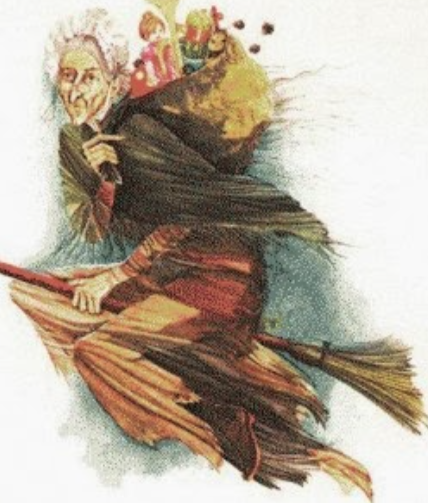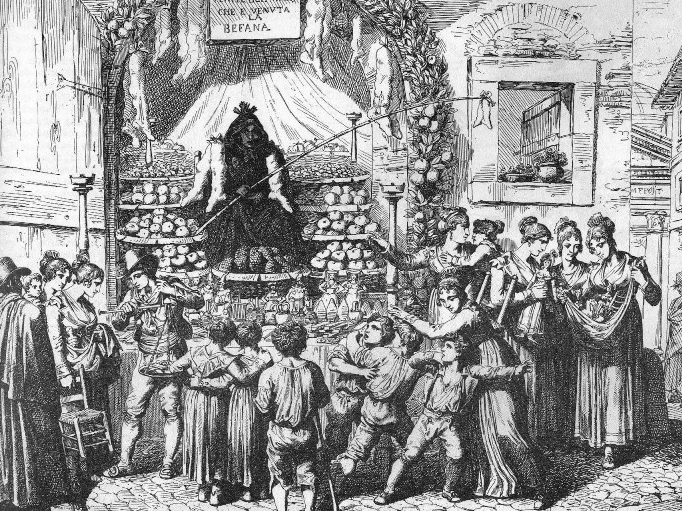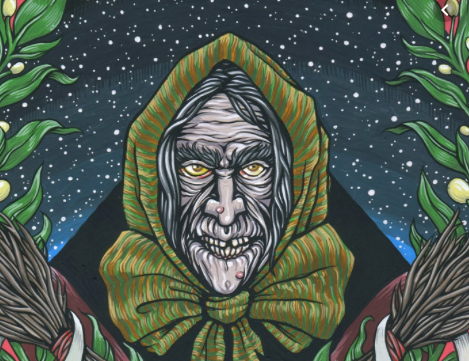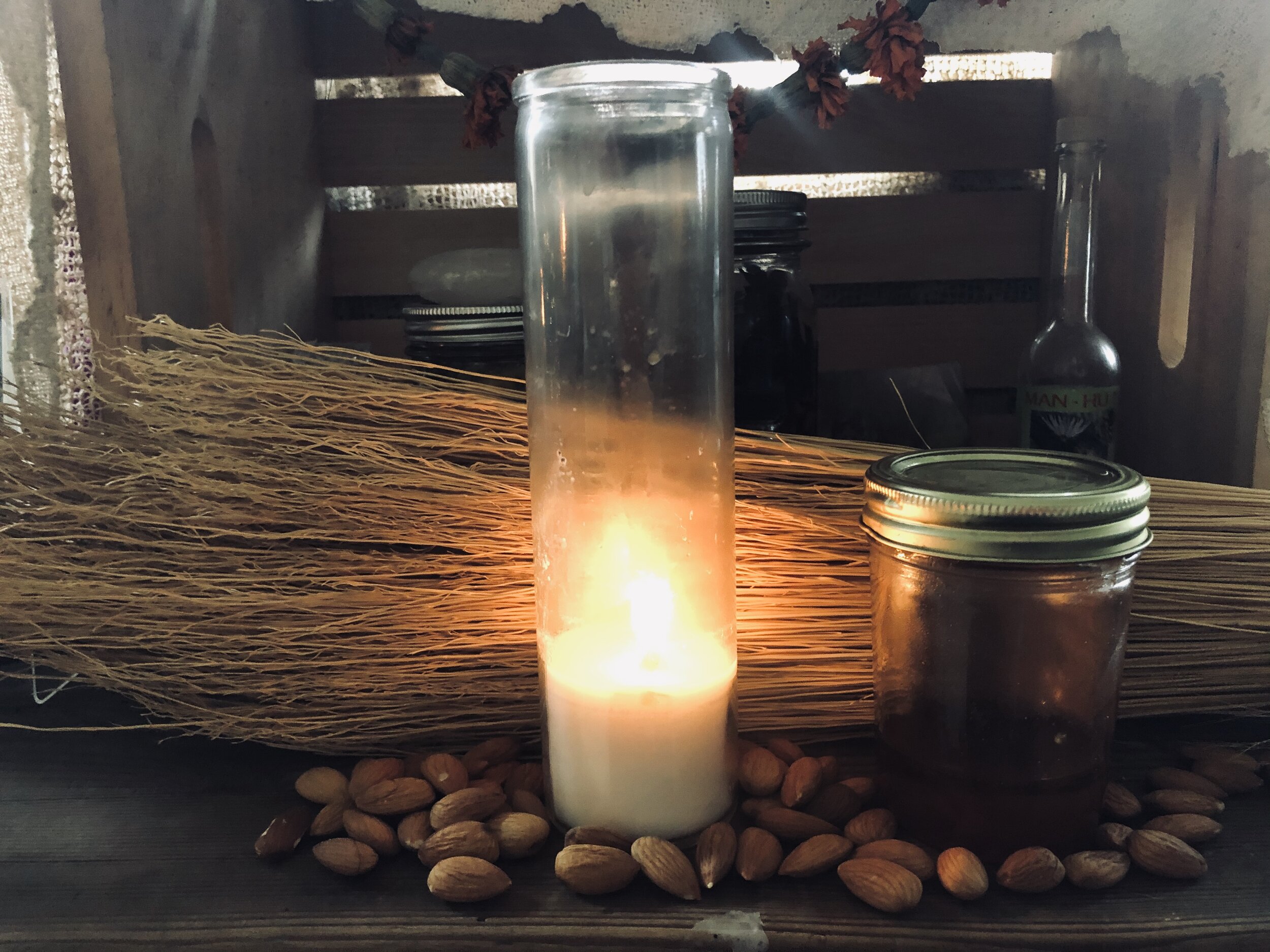La Befana: Christmas Witch, Goddess of Ancestral Spirit, fascist propaganda (+ Befanini recipe and spell)
This winter crone is known as a wise, mystical, and magical woman with a broom as her portal, bringing gifts to children throughout Italy on the Epiphany.
She’s more popular than Santa in some parts of Italy— and it’s been passed down to me that she represents the liminal space between ancestors and children, not unlike how the ancestors deliver candy to the children on Il Morti. She is the one who keeps the bond alive between the worlds of this season, delivering sacred treats of nuts, figs, sweets from the otherworld to this one, reaffirming the connection between the living and the dead.
powerful image of La Befana by Samantha Janara IG @SamanthaJanara
I have been told she’s associated with southern Italian ancestor worship, during the time that is “between” worlds— before the revelation of Christ as god through the visit of the Magi/3 Wise Men. (Epiphany means “appearance” or “manifestation” —and during the 12 days between Christmas Day and Epiphany on January 6th are the days for us to live in the liminal space, to wait, be brought to our own “epiphany” about our lives”. In this way, Befana feels like the midwife, the gatekeeper between worlds, not unlike Lucy. She comes, as so many deities and saints during their time of feast, as figures and helpers of our own transitions. When I see Befana I’m brought to the image of Hecate and a dream I had with her in it when I was in my mid-twenties and began practicing dream temple work. The dream was of an old Hag with a broom in her hands. She was hunched over, wise wrinkles deep like deep cracks in her face, and cloaked in black, who told me she was Hecate Befana. She was sweeping a very dirty attic and informed me she was sweeping my consciousness clean. She told me she was the midwife of death. I like to think of Befana as an expression of Hecate during these twelve days where we wait for that “revelation/appearance/manifestation” to happen— sweeping our consciousness clean so we can discover new things about who we are, why we are here. A time we can allow our old selves to die off, with her help, sweeping away the remnants of what was.
But these are my own personal and intuitive connections to this wise old one. There is a lot of talk about her, so I wanted to share some of the bits and pieces that have come through to me through storytelling and research….
Where does this name “Befana” actually come from? Although discussed by many, nobody has come up with a conclusive answer about where it’s derived from. Many folklorists believe that the name Befana is just a mispronunciation in Italian of the Greek work Epifania. I can totally hear that, in Italian, sounding like Befana. AMIRIGHT?
But let’s bring in another ancient name and figure: Strina.
mosiac of Strina.
This goddess Strina, also called Strenia (or Strenua), is the Sabine/Roman goddess of the New Year. The goddess of purification, of spiritual, emotional, physical wellbeing. Of new life. Some believe the Befana tradition of bringing gifts is derived by the Strenua cult. In the book Vestiges of Ancient Manners and Customs, Discoverable in Modern Italy and Sicily by Rev. John J. Blunt (John Murray, 1823), the author says:
"This Befana appears to be heir at law of a certain heathen goddess called Strenia, who presided over the new-year's gifts, 'Strenae,' from which, indeed, she derived her name. Her presents were of the same description as those of the Befana—figs, dates, and honey.”
Mary E. Rogers, writing back in the 19th century (Domestic Life in Palestine) believed that the act of exchanging gifts during this season stems from being “a relic of pagan worship, and that the word ‘Bastrina’ refers to the offerings which used to be made to the goddess Strenia” And the word “Bastrina” eventually became “Befana”.
La Befana, who is now known as the “Christmas Witch” spends her days cleaning and sweeping, keeping her home tidy, and on the Eve of Epiphany she delivers sweets to the kids. Popular and modern tradition says that La Befana does not want to be seen, so if you try and look for her and see her, you’ll get a smack from her magical broomstick when you least expect it. In the most common modern tellings of the Italian tale, La Befana’s famous midnight ride is done on her very magical broomstick (sometimes she appears on a donkey, which was a way of subduing her magic, in my opinion), which is a symbolic element of witchcraft and also a keeper of the homestead— two very “traditionally” feminine ways of being (I say traditionally in reference to an article I quote a little further on in this post)*
Judika Illes says: “Befana may predate Christianity and may originally be a goddess of ancestral spirits, forest, and the passage of time. Some identify this wandering, nocturnal crone with Hekate.” When I read this from the ever-amazing Illes, I was validated in my long time thoughts about Hecate and Befana— and in my dream—they are the keepers of a changing time, a clearing time, a sweeping away of time. A time of crossroads and thresholds. Their brooms bring clarity and protect us. And ask us to look at the magic we want to make in this new year. Ask us to get clear and define choices for ourselves— or perhaps trust the choices we allow to be made for us once we release ourselves from our old selves. If she is associated with Strina also known as “Strenua” then the Befana tradition is derived from the Strenua witch-cult (which is very popular in Sicily still). Strenua symbols: Verbena, Bay Laurel, Palm, Honey, Figs, Leaves, Money and Gold Coins. Strenua had a shrine and grove at the top of the Via Sacra and there within her grove grew Verbena, which was considered to be sacred (Wikipedia). It is said that Strenia is associated with New Year’ Day, she presides over words of encouragement, as well as gifts of good scented omens in the form of branches of Verbena.
art by Bartolomeo Pinelli
Perhaps Befana is the conductor for both these ancient goddesses- she sweeps away the old year, allowing it to die (Hecate) making room for healing and newness and good omens in the new year (Strenua).
Two other important observations are, according to Carlo Ginzburg: “ (1) She is part of the European witchcraft tradition and the nature of “ecstasy”. (2) Her origins go back all the way to the time of the pre-patriarchal, Neolithic “Goddess cultures” . We can also trace Befana and Neolithic beliefs and practices that connect her to traditions related to the Italian agricultural cycle.
artist unknown.
I offer you all these tidbits of info that I’ve learned and gathered because it’s clear to me that Befana, regardless of her myths throughout the Italian/Sicilian folk lore, La Befana is living proof of the survival from the Great Goddesses of our ancestral past. No matter who she is born from and how far back she goes, she is the living proof of the remains of a time where all aspects of the Mother had reverence and power and magic. These goddesses were, because of the rise of patriarchy, either repressed, demoted to minor deities, or turned into demonic forces or domestic figures, with little to no real power. In my research I found some very fascinating articles on the evolution of this “Winter Witch” used to help with the rise of Fascism— for instance in this academic paper* (the reason for my “traditional feminine” quote above) talks about the assertion of traditional gender roles and propaganda of Italian Nationalism through Befana during the rise of Facism in Italy:
The regime instrumentalized popular folk characters such as the Befana and Pinocchio and co opted historical figures such as Giuseppe Garibaldi and Vincenzo Bellini to build popular devotion towards fascism as a new powerful civic religion centered on nationalism. Through these figures, the regime created, altered, and even exaggerated national myths to support the fascist political agenda and strengthen popular loyalties.
Fascists constantly struggled between reasserting tradition and modernizing the country. For instance, the Befana, an old woman who distributed gifts during the epiphany, was a well-established Italian figure. When appropriated by the fascists, however, the Befana illustrated how the regime intended to assert traditional gender roles through a folk figure. The fascist version of the epiphany celebrations had the Befana distribute specific gifts that were based on gender. The celebration, as an instrument of social welfare, also displayed the government’s commitment to modernization by attempting to eliminate social inequalities.
In this article, we learn more about this particular re-birth of Befana, and the ridding the very Nordic Santa in Italy, and bringing back a “nationalist” and “let’s glorify Italy” tradition, making Befana less neolithic and pagan, and taking her and turning her into the new Italy Mussolini style —— (sound familiar ahem: “MAGA”?) for the holiday:
Italians have been celebrating this sweet (fierce*) witch since (before*) pagan times, but it was only in 1928 that Benito Mussolini established the Epifania (Epiphany) festivity on January 6, making it a national holiday and linking the witch’s arrival to that of the three wise men visiting Baby Jesus’ stable to bring him gifts. It was typical of the regime to appropriate pagan and Roman myths or symbols to glorify the regime as part of “Mussolini’s fascistization of society,” says Andrea Ungari, a history professor at Rome’s LUISS University. Pushed by the ideal of great ancient Rome, Mussolini quite cleverly adapted (and adopted) the tale of the fertility and abundance goddesses who flew over fields at night to bless harvests to the Befana myth. There is also a link to a Christian legend, which says the three kings, on their way to visit the infant Jesus, stopped by the cottage of an old lady and asked her to join them on their holy pilgrimage. She refused but later felt guilty for not going, which prompted her to hop on her magical broom and visit children’s homes around the globe, presents in hand.
*my additions to their article
“La Befana vien di notte
Con le scarpe tutte rotte
Col vestito alla romana
Viva, Viva La Befana!”
Once again, the goddess is appropriated, given a new role, and stripped down of her true gifts and power, and used for social and political gain.
I am going to get back to my magical dream that happened in 1999, where this old woman with a broom told me she was Hecate Befana and here to clean me out. This is the energy I lean into and put on my altar these in-between days. She is powerful symbol, perhaps more powerful than we can ever be taught, but somewhere in our cellular memory, we know. We know who these mythological figures were, what they were for, and how we can pay them honor and receive their magic in these liminal days.
What if these days before epiphany were meant to spent in deep spell work and meditation? What if our ancestors sat in prayer and contemplation, in ritual cleansing, banging that broom against the wall, beating all the bedding, sprinkling salt all over the floors, leaving lemon in the corners, and lying honey and figs and nuts upon the altar offerings to both the goddess of new years and the goddess of death and rebirth?
I invite you to allow Befana, this ancestral guide, to come to you as you need these days. Allow Befana to come as she is. Ask her for what you need. Leave her offerings. Clean out your spaces. Free yourself up some space. Ask for an epiphany. Ask for a reason. Ask for a blessing. In return give your time and energy to sitting in openness, in prayer, in magic.
Offerings for a spell for this new year:
Figs or dates or nuts (any offering of these three)
A small cup of honey
A clean broom
a candle
Create a simple altar to Befana with your dried fruit or nuts and honey. Light your candle on the altar now or on the eve of the 5th. Sit there for as long as you need daily, asking for wisdom, power, a good cleanse, and some information for the new year. When you are done sitting, take your broom and sweep the air, the walls, the ceiling, the floors. Lay the broom outside with all the dust on it, and smack it around to release the dirt. Do this intentionally, cleaning out the stuff in your life you no longer want. Give thanks to the ancient witch of the season. May all be blessed and protected.
ANNNDDD… if you want a delghtful cookie recipe to make, try these Befanini cookies. They are delicious, crips, and buttery. Because every feast day needs cookies. RIGHT?
xx









